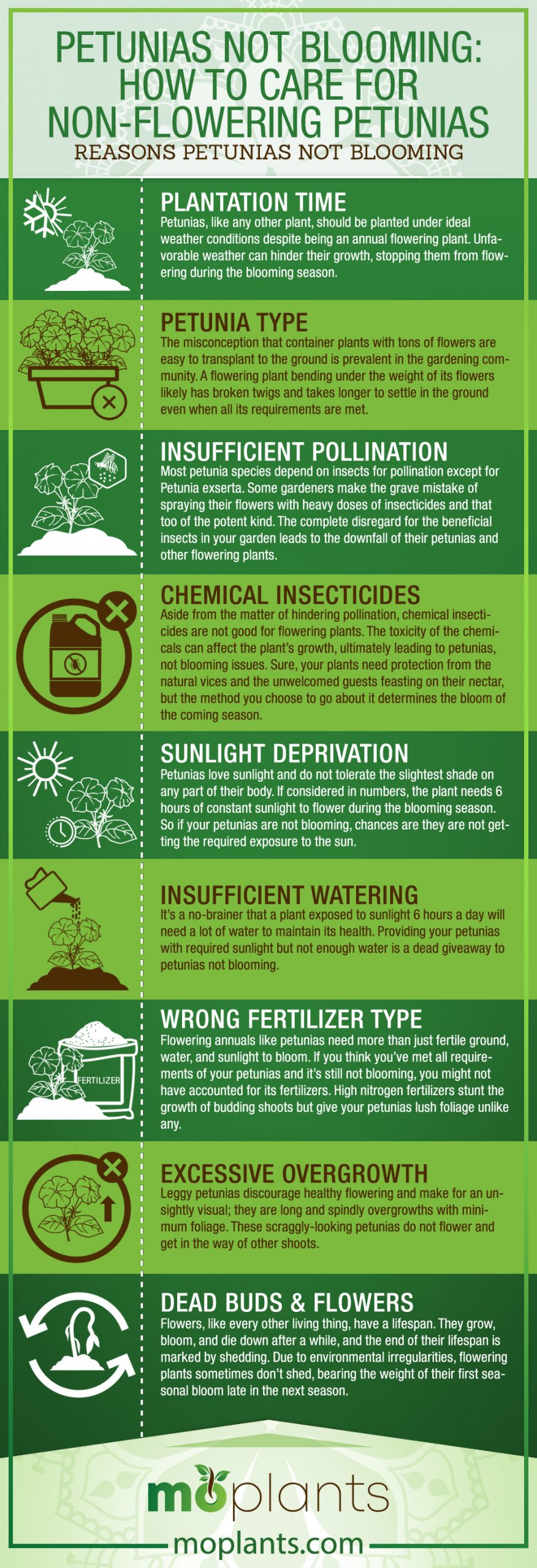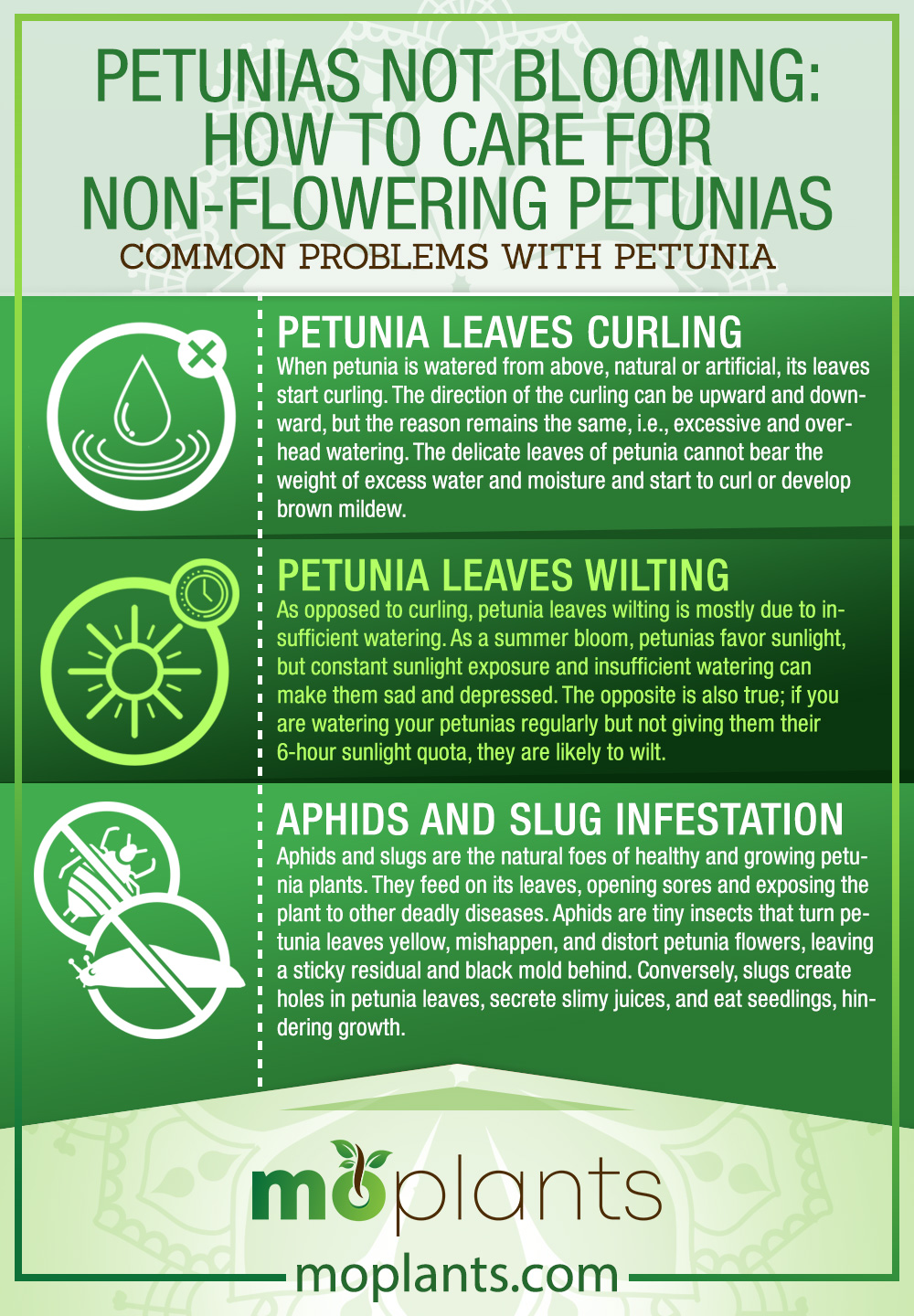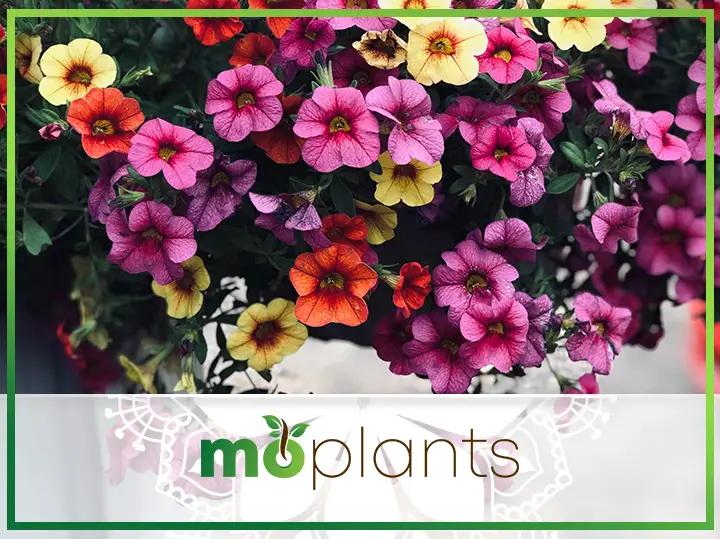Petunias are famous flowering annuals known to bring life to borders and beds in gardens with their bright and lively colors. This summer favorite is a staple in well-maintained gardens in sunlit countries across the globe.
Praised for their ornamental varieties, petunias are a sound choice to add a smatter of color to your garden as they are easy to grow and care for. They are a treat to your eyes in full bloom and impart a therapeutic effect typical of only flowering plants. Under its favored conditions, the plant grows rapidly, covering the hard edges of your garden and adding a soft luminance to its visual. All you need is a bright spot, fertile soil, and the right feed to acquire a scenic view for your house.
But what if you’ve done the needful and still, your petunias are not blooming?
Petunias not blooming issue is nothing new, and there are many reasons that can lead to this damning outcome.
Scroll down to see what’s troubling your petunias:
Reasons Petunias Not Blooming
If you can’t seem to make your petunias flower, you might be doing one of the following things wrong:
Plantation Time
Petunias, like any other plant, should be planted under ideal weather conditions despite being an annual flowering plant. Unfavorable weather can hinder their growth, stopping them from flowering during the blooming season.
Petunia Type
The misconception that container plants with tons of flowers are easy to transplant to the ground is prevalent in the gardening community. A flowering plant bending under the weight of its flowers likely has broken twigs and takes longer to settle in the ground even when all its requirements are met.
Insufficient Pollination
Most petunia species depend on insects for pollination except for Petunia exserta. Some gardeners make the grave mistake of spraying their flowers with heavy doses of insecticides and that too of the potent kind. The complete disregard for the beneficial insects in your garden leads to the downfall of their petunias and other flowering plants.
Chemical Insecticides
Aside from the matter of hindering pollination, chemical insecticides are not good for flowering plants. The toxicity of the chemicals can affect the plant’s growth, ultimately leading to petunias, not blooming issues. Sure, your plants need protection from the natural vices and the unwelcomed guests feasting on their nectar, but the method you choose to go about it determines the bloom of the coming season.
Sunlight Deprivation
Petunias love sunlight and do not tolerate the slightest shade on any part of their body. If considered in numbers, the plant needs 6 hours of constant sunlight to flower during the blooming season. So if your petunias are not blooming, chances are they are not getting the required exposure to the sun.
Insufficient Watering
It’s a no-brainer that a plant exposed to sunlight 6 hours a day will need a lot of water to maintain its health. Providing your petunias with required sunlight but not enough water is a dead giveaway to petunias not blooming.
Wrong Fertilizer Type
Flowering annuals like petunias need more than just fertile ground, water, and sunlight to bloom. If you think you’ve met all requirements of your petunias and it’s still not blooming, you might not have accounted for its fertilizers. High nitrogen fertilizers stunt the growth of budding shoots but give your petunias lush foliage unlike any. The rapid growth of its leaves can give the impression that the plant is healthy when, in fact, it is falling short of its main purpose, i.e., adding ornamental value to your garden.
Excessive Overgrowth
Leggy petunias discourage healthy flowering and make for an unsightly visual; they are long and spindly overgrowths with minimum foliage. These scraggly-looking petunias do not flower and get in the way of other shoots.
Dead Buds & Flowers
Flowers, like every other living thing, have a lifespan. They grow, bloom, and die down after a while, and the end of their lifespan is marked by shedding. Due to environmental irregularities, flowering plants sometimes don’t shed, bearing the weight of their first seasonal bloom late in the next season. These dead flowers restrict the growth of new buds and affect the second bloom indefinitely.
Infographic

How to Fix Petunia Non-Flowering Issue
Not being able to see the physical manifestation of your hard work can be daunting but petunias not blooming issue is nothing that cannot be rectified.
Here’s how you can allow your petunias to bloom:
Suitable Weather Conditions
The ideal time to plant these summer blooms is after the last frost date in spring. But with petunia seeds, you can grow them indoors 8-10 weeks prior to the last frost date and then to the fertile ground after the frost breaks. Late frost bouts can affect their optimal growth, so growing them in a container is better.
Petunia Varieties
While choosing a petunia plant, pick those that are short but solid with budding shoots. Be mindful of the seed types if you want to grow your petunia from the seeds instead of the plug plants.
Different petunia varieties give distinct flowers and add versatility to your garden’s aesthetic. Some of them are listed below:
- Millifloras: These are small in shape and appear to be in clusters. They bloom throughout the season.
- Floribundas: These produce medium-size flowers and flow freely in all directions. They require regular trimming for proper shape.
- Grandiflora: These flowers are large in size but bloom in fewer quantities. They are not meant for high humid areas and intense summers.
- Multiflora: These produce flowers in abundance and can withstand harsher environments.
Enable Pollination
You might think planting a petunia in the brightest spot of your garden should bear booming results, but petunias need insects and, in exserta’s case, hummingbirds to propagate in the area around them. A single petunia plant cannot deliver the spilling spectacle of colors you might have envisioned while planting them. This is why they need insects, wind, and other resources to disperse their seeds and grow in their surroundings to ensure a cluster presence. Simply put, not all insects are harmful to your plants; some just need to be controlled in quantity.
Risk-Free Insecticides
Plant-based or herbal insecticides are safer and degradable alternatives to chemical insecticides. They pose no threat to you, your plants, or the environment. Even biological insecticides do the job just as effectively without making your petunias lose their flowering capabilities. For instance, Diatomaceous earth (fossil algae) can be effective against caterpillars, whereas garlic spray can kill aphids.
Proper Lighting
Depending on the position of the plants in your garden, your petunias may be getting 6 hours of sunlight but in parts. Therefore, you must time the sunlight exposure to your petunias throughout the day to know for sure. If the problem is sunlight deprivation, you need to transplant your petunias to a sunny spot in your garden.
Petunias in containers and baskets can just be moved from one pace to another but transplanting petunias is a bit tricky.
Here’s how you can do it:
- Step 1: Pick the sunniest spot in your garden.
- Step 2: Remove all the debris, stones, leaves, and fertilizer residue from the selected spot.
- Step 3: Prepare the soil by adding organic matter (garden compost or fertilizer).
- Step 4: Dig the whole just enough that the root ball becomes level with the ground.
- Step 5: Mulch the ground with an added layer of compost or manure.
- Step 6: Water the ground enough to keep it moist and not soggy.
Meeting Water Requirements
All petunia varieties need regular watering to stay in their prime. Regular watering doesn’t necessarily mean every day; three times a week should be enough unless you live in a region with long dry summer spells. Additionally, ensure that you water the root ground of the plants instead of the flowers. Prolonged and constant moisture on flowers can lead to powdery mildew growth on the petals.
When the upper layer of soil seems dry in petunia containers, gardeners keep watering them, not knowing that the water is being sucked to the bottom of the container. Lift your petunia containers to judge their weight; if the containers are heavy, there is likely water at their bottom. Petunias containers should have holes on the sides for water drainage. If not, the constant waterlogging can cause root rot.
Balanced Nutrients
The kind of nutrients you feed to your petunias determine the frequency and density of their flowering. Most petunias fare well when supplied with water-soluble fertilizers high in phosphorus. Since regular watering can drain the feed, the ground must be fertilized after every watering session.
Look for the fertilizers with the highest middle number in the 3-digit fertilizer ratio. Most fertilizers categorized as “bloom promoters” are high in phosphorous. Some gardeners use bone meal in their garden compost as a natural phosphorous resource.
Pruning & Trimming
Pruning may seem disadvantageous, but it enables healthy growth when you get rid of dead and non-reproductive ends. Midsummer pruning, right after the first seasonal bloom, gives way to a second bloom in the later half of the season.
In the case of leggy petunias, cut the overgrowths by one-third of their original length.
Deadheading
In horticulture, deadheading is a proven practice that helps remove the dead flowers and buds from an ornamental plant. Like pruning, gardeners use deadheading to encourage healthy bloom for the next season.
Common Problems With Petunia
There are some problems that don’t affect petunia flowering directly but as a side effect. Some of these problems, if left unchecked, can yield damning consequences for not your petunias but other flowering plants in their vicinity too.
We have listed the common problems with petunia plants below:
Petunia Leaves Curling
When petunia is watered from above, natural or artificial, its leaves start curling. The direction of the curling can be upward and downward, but the reason remains the same, i.e., excessive and overhead watering. The delicate leaves of petunia cannot bear the weight of excess water and moisture and start to curl or develop brown mildew.
Hence, it is advised to water flowering plants like petunia at ground level, soaking only the root and the soil. If you notice curled leaves even after regular sprinkling, don’t panic. Curling can be an immediate effect of watering; with enough sunlight exposure, the moisture will evaporate, allowing the leaves to retain their original shape.
Petunia Leaves Wilting
As opposed to curling, petunia leaves wilting is mostly due to insufficient watering. As a summer bloom, petunias favor sunlight, but constant sunlight exposure and insufficient watering can make them sad and depressed. The opposite is also true; if you are watering your petunias regularly but not giving them their 6-hour sunlight quota, they are likely to wilt.
In essence, petunia leaves wilting means one of its many nutrient or conditional requirement is not being met, including its feed.
Aphids and Slug Infestation
Aphids and slugs are the natural foes of healthy and growing petunia plants. They feed on its leaves, opening sores and exposing the plant to other deadly diseases. Aphids are tiny insects that turn petunia leaves yellow, mishappen, and distort petunia flowers, leaving a sticky residual and black mold behind. Conversely, slugs create holes in petunia leaves, secrete slimy juices, and eat seedlings, hindering growth.
You can use biological or herbal insecticides to kill the aphids or release predators like lady beetles or spiders on them. If you find a cluster of them on a shoot or flowers, trim the edges or cut off the shoot entirely.
You can handpick and drown slugs in beer or sugar water to combat them. As a precautionary measure, lay thick planks on the soil around your petunia plants and steer clear of overhead watering. Diatomaceous earth works aphids and slugs both and is a risk-free method to kill off most pesticides.
Infographic

The Bottom Line
This article has covered everything that can lead to your petunias not blooming along with their solutions. As long as you meet the nutrient requirements of your petunias and enable favorable environmental conditions, they should bloom not once but twice in the season.

